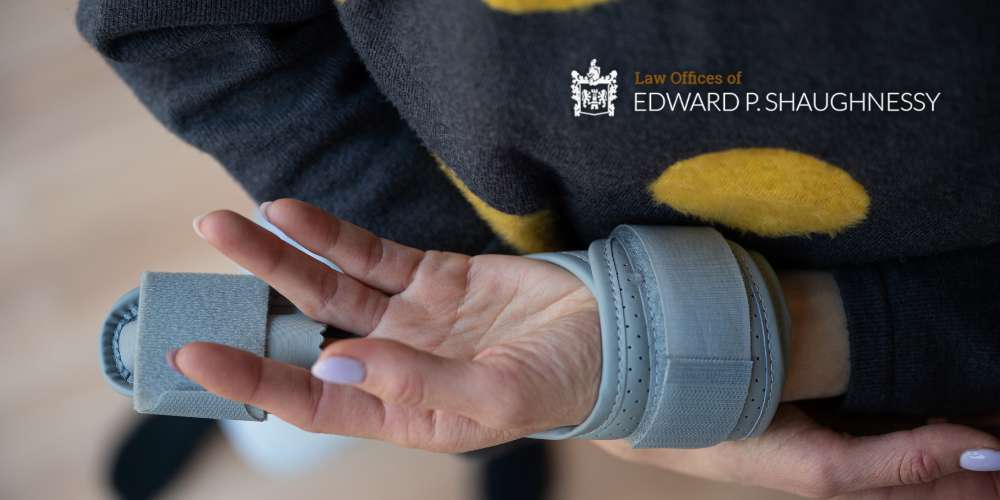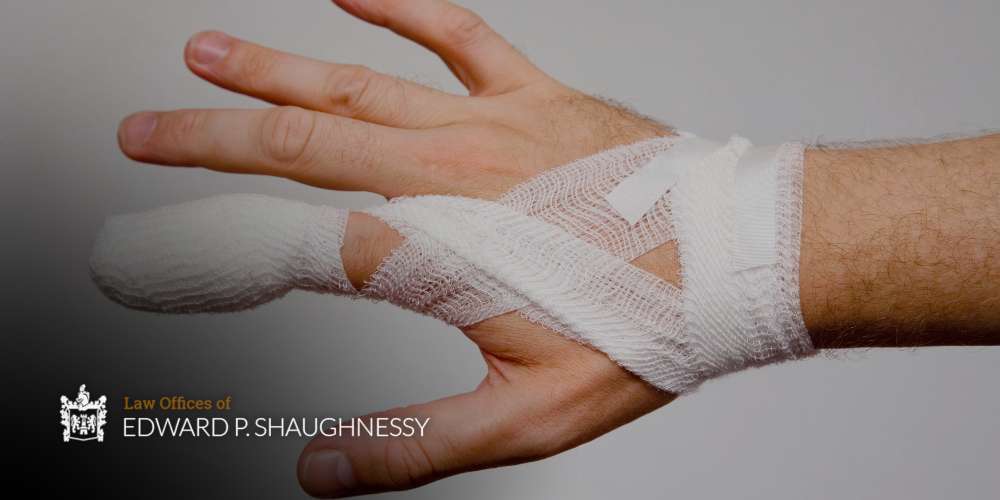In the grand scheme of things, a sprained or broken finger may seem minor. However, the extent to which the injuries can impact your life can be surprising. But what is the difference between a sprained finger vs. broken finger, and what can you do about this kind of injury?
If your finger was broken as a result of another person’s negligence, you may have grounds to file a personal injury case. Easton personal injury lawyer Edward P. Shaughnessy is prepared to use his experience in personal injury law to pursue justice for clients suffering from personal injuries of all types.
Contact the Law Offices of Edward P. Shaughnessy today at (610) 258-9955 to learn more or schedule a free consultation.
Difference Between Sprained and Broken Finger
A sprained finger occurs as a result of damage to soft tissues within your finger, like the ligaments. When your finger is sprained, the ligaments are likely damaged, and could be partially torn or even completely torn.
Broken fingers, on the other hand, involve damage to the bone or finger joints. When a bone breaks or fractures, you will likely need to seek medical treatment to address the injury and ensure a smooth healing process.
Sprained vs Jammed Finger
In general, “jammed” and “sprained” are terms that can be used interchangeably, meaning a “jammed finger” is the same as a sprained finger.
Broken vs Fractured Finger
Additionally, a “fractured” bone also refers to a broken bone, so a “fractured finger” is a broken finger.
Common Causes of Finger Injuries
There are many potential causes for an injured finger. Some common causes for both jammed fingers and broken fingers include:
- Excessive Force – If too much pressure is applied to your finger, you may experience severe pain and/or injury. This could include bending your finger backward, slamming it in a door, or hitting it against a solid object.
- Sports – Fast-moving objects, sporting equipment, and other players may cause broken or jammed fingers.
- Falls – When you fall, it’s a natural instinct to try to catch yourself. However, this could lead you to fracture your finger in the fall.
- Work Accidents – Tools, such as drills or hammers, or activities that lead to overuse or strain, can cause injuries to the fingers.
- Car Accidents – Auto accidents occur every day, and finger or hand injuries from car accidents are common. Even minor collisions can result in injuries that need your attention.
Risk Factors for Broken Fingers
Certain conditions may put you at an increased risk of finger fracture. Conditions affecting bone strength are a notable risk factor for broken fingers. If you have a calcium deficiency or lack vitamin D, you may be more likely to break a finger. Additionally, medical conditions such as metabolic bone disease, osteomalacia, and osteoporosis can cause broken bones to occur more easily.
More general health concerns can also increase your risk of a broken bone. For example, infection or malnutrition can also lead to an increased risk of bone fractures.

How to Tell if Finger is Broken or Sprained
There is some overlap in symptoms for broken and jammed fingers, so it can be difficult to tell how severe your injury is. Below are some tips on how to tell if your finger is broken or if it’s just sprained, as well as a few key differences in their symptoms.
How to Tell if Your Finger is Broken
A broken finger typically results in intense pain. During the injury, you may hear audible popping or cracking sounds. A break will often leave your finger unstable and can result in a noticeable visual difference, such as leaving your finger in a strange position. If your finger is bent at an odd angle or looks disfigured, you may have a broken finger.
Can You Still Move a Broken Finger?
Usually, if you break your finger, you will not be able to move it. However, finger fractures can vary greatly, and your injury may only partially limit finger mobility.
Sprained Finger Symptoms
If you sprain your finger, you’ll likely experience localized pain, swelling, bruising, and/or difficulty bending or holding your finger straight. You may also experience stiffness or tenderness in the affected finger.
You should not experience extreme pain, incredibly limited mobility, or visible disfiguration if you have a sprained finger. However, if you’re experiencing any symptoms that concern you, like significant swelling, pain that doesn’t subside, or persistent mobility issues, seek medical attention.
How to Treat a Broken Finger
If you suspect you have a broken finger, consult with a medical professional. For most finger fractures, treatment will involve using a splint, letting the finger rest, and taking over-the-counter pain medications to relieve pain.
Stable fractures might only require a simple splint, but some fractures can require a cast that extends to the elbow. A more severe fracture, like a complex fracture, may also require surgery to reset the bone. If you experience severely limited mobility after the splint or cast is removed, your doctor may recommend physical therapy. This can also ensure that your finger is healing properly, following immobilization or any surgery.
How Long Does a Broken Finger Take to Heal?
A broken finger can take several weeks to a year to heal. Just like with any broken bone, healing a broken finger properly can take time, so it is important to be patient.
How to Treat a Sprained Finger
In general, a sprained finger can be treated using the RICE method: rest, ice, compression, and elevation. Keep the injured finger elevated over the heart, gently wrapped in a bandage, and cooled with an ice pack following the injury. Over-the-counter pain relievers and anti-inflammatory medications can also ease pain and swelling.
The best way to make sure your sprained finger heals is to rest it. Some finger sprains can heal significantly with rest alone. Typically, these kinds of sprains heal within a few weeks.

When to Seek Medical Attention for a Finger Injury
If you’re not certain whether your finger is broken or not, seek medical attention just to be safe. A doctor can order imaging tests to determine whether the finger is sprained or broken, and then determine the best treatment options for your injury. Waiting too long to treat your injury can lead to improper healing or other long-lasting issues.
Some injuries require immediate medical attention to limit damage. Compound fractures, crush injuries, and amputation require immediate attention and proper treatment in order to ensure a safe recovery. Don’t hesitate to seek care simply because you think you can tolerate the pain. Trust in a trained medical team to help you heal and recover.
Can You File a Personal Injury Claim for a Finger Injury?
In some situations, yes, you may be able to file a personal injury claim for a finger injury. If your finger injury was the result of someone else’s negligence, you may be able to file a suit to recover the damages you suffered. This could include situations like:
- A car accident caused by another driver
- A slip and fall caused by a negligent property owner
- A workplace accident caused by unsafe equipment, inadequate training, or overuse
If you believe your finger was injured as a result of another person’s negligence, don’t wait to seek the professional legal support you deserve. A broken bone lawyer in Easton, PA, like Edward P. Shaughnessy, can evaluate the circumstances of your accident and determine whether or not you have a claim. Additionally, our team can help you recover compensation for your losses, such as pain and suffering, medical expenses, lost wages, and more.

Suffered from a Finger Injury? Call Easton, PA Personal Injury Lawyer Ed Shaughnessy Today
Any injury can be painful and can significantly impact your day-to-day life, including finger injuries. Whether you’ve experienced a sprain, hairline fracture, or severe break, you may be able to recover compensation for your losses, depending on the circumstances of your injury.
As an experienced Easton personal injury attorney, Ed Shaughnessy brings extensive knowledge to every case he takes on. Our legal team is here to support you throughout the legal process and ensure you receive the best possible outcome in your case.
Don’t wait: learn more about our PA personal injury legal services and how we can help you financially recover from your injuries. Contact Ed Shaughnessy via our online contact form or call (610) 258-9955 to schedule your confidential consultation today.






